Why is it important for organisations to look at diversity beyond gender? | Sonica Aron | Managing Partner and Founder | Marching Sheep

Organisations are at a critical turning point in terms of diversity and inclusion in an era marked by major developments in the world of work. While gender diversity with a focus on representation of women in the workforce has historically been the main focus of most organisations the current context necessitates looking at Inclusion from a broader lens. Today’s workplaces are characterised and impacted by a remarkable convergence of factors: a workforce representing a broad range of ethnicities, ages, sexual orientations, talents, and backgrounds along with an evolving PESTEL (Political, Economic, Social, Technological, environmental and Legal) ecosystem. The fusion and intersectionality of identities and experiences in the workforce, along with evolving working environments both benefits organisations and challenges them in ways that have hitherto been unexplored and not experienced.
The need to broaden the inclusion agenda originates from the recognition that diversity is a complex tapestry with many strands. Organizations must now embrace and promote it in order to fully unleash the creative, innovative power it holds to be agile in problem solving, decision making, and meeting the needs of an ever-changing marketplace. While we need to keep the pedal pressed as far as inclusion of women is concerned, to encourage and nurture the broader dimensions of diversity, we must value the diverse identities that comprise our modern workforce. Thus, in order to create workplaces that are inclusive of all differences businesses must widen their definition of diversity to encompass a wide range of factors. According to McKinsey, gender and ethnic diversity both increase a company’s likelihood of outperforming its competitors by 15% and 35%, respectively.
Here’s a look at the essential factors that are important for organisations to look at-
Evolving Workforce Dynamics
The dynamics of the contemporary workforce are constantly changing. Workplaces today are more diverse than ever before thanks to factors including globalization, technological development, and shifting social standards. In addition to gender, diversity also takes into account race, culture, age, sexual orientation, life stages, educational background, cognitive diversity and a lot more. Such complex workforce dynamics necessitate a change in organizational thinking, culture and way of working. When considering the many viewpoints and talents that people from all backgrounds bring, merely focusing on gender representation is no longer sufficient. Hence, organisations must recognise and value this rich diversity, understanding that it is the sum of these distinctions that fosters productivity, innovation, and creativity at work.
Multigenerational Teams
The concept of generational diversity is gaining traction in the workplace today. Millennials, Generation X, Baby Boomers, and Generation Z are all now coworkers in the same organisations. Each generation has its own set of ideals, communication habits, work practices, and expectations. If organisations wish to effectively tap into the combined potential of these multigenerational teams, they must look beyond stereotyping each generation and leverage the strengths and collaboration between them instead. It is critical to acknowledge and capitalise on each generation’s contributions. In addition, recognising that diversity extends far beyond gender and gender and generations intersect, businesses can establish environments in which generational differences are encouraged rather than tolerated, enabling better collaboration, information sharing, and more agile culture.
Consumer Expectations
Consumers of today are extremely woke, informed and mindful; they are also increasingly conscious agents of societal change. Today, a significant portion of the market prefers businesses that share their values, with inclusion at topping the list. Businesses that go beyond gender in their commitment to diversity are better positioned to connect with socially conscious customers. These customers actively seek out companies that value inclusion by embracing diversity in its broadest sense. As a result, broadening the varied narrative beyond gender is both a strategic commercial need and an issue of corporate responsibility. It can increase brand loyalty, encourage customer interaction, and guarantee an organization’s viability in a market that is constantly changing.
Authentic Inclusivity
As the need for real inclusivity grows, the era of token diversity initiatives and strict gender quotas is fading. Workforce today, in particular, demands more than merely empty promises. They want to work for companies that truly respect and value diversity. It is no longer enough to have one’s diversity agenda on the website. Today’s networked talent pool can find out the inside story through their vast network of ex-colleagues, batch mates and friends. People from the LGBTQIA community, people with disabilities in particular look for organizations that are prepared in terms of infrastructure, policies and practices, leadership buy-in, managerial sensitization. They are not keen on ‘any job’ in ‘any company’ but are making mindful choices. A thought through broadened inclusion strategy encourages the development of a work environment where people are empowered to contribute irrespective of their gender, sexuality, disability, culture, language, life stage. This authenticity not only attracts top talent but also creates an environment where innovation thrives, leading to sustained organizational growth and success.
Embracing Diversity Beyond Gender!
There is no denying the necessity for organisations to broaden their emphasis beyond gender in order to promote diversity and inclusion. Our workforce expectations and demographics are evolving at a fast pace and are characterised by a wide range of identities and experiences. It’s crucial to embrace this complex tapestry of diversity, which spans age, sexual preference, ethnicity, and more. Organisations cannot continue to deny or live in a bubble, or not hasten their inclusion initiatives if they indeed want to win over the right talent and achieve sustainable growth and success.


